马上注册,结交更多好友,享用更多功能,让你轻松玩转社区。
您需要 登录 才可以下载或查看,没有账号?立即注册
x
该项目位于印度的加尔各答,是一套错层式的住宅,拥有独特的空间配置和楼板设计。房屋共有三个楼层,每层面积约700平方英尺(约65平方米),它们相互连接在一起,并带来无障碍的视野。半程楼梯成为设计中的亮点元素,为各层之间提供了纽带和物理分隔。
Offering a unique configuration of spaces and a distinctive floor plate– Upstairs is a split-level house located in Kolkata. It is divided into three levels with an area of around 700 sqft each, wherein there is a connection between different levels offering an unobstructed view of each floor. Hence, the staircase here acts as a connecting link and as a physical barricade between two levels. Since it is a split level, therefore half flight staircases are used, making them a standout element of the design.
▼项目概览,Preview © Ishita Sitwala
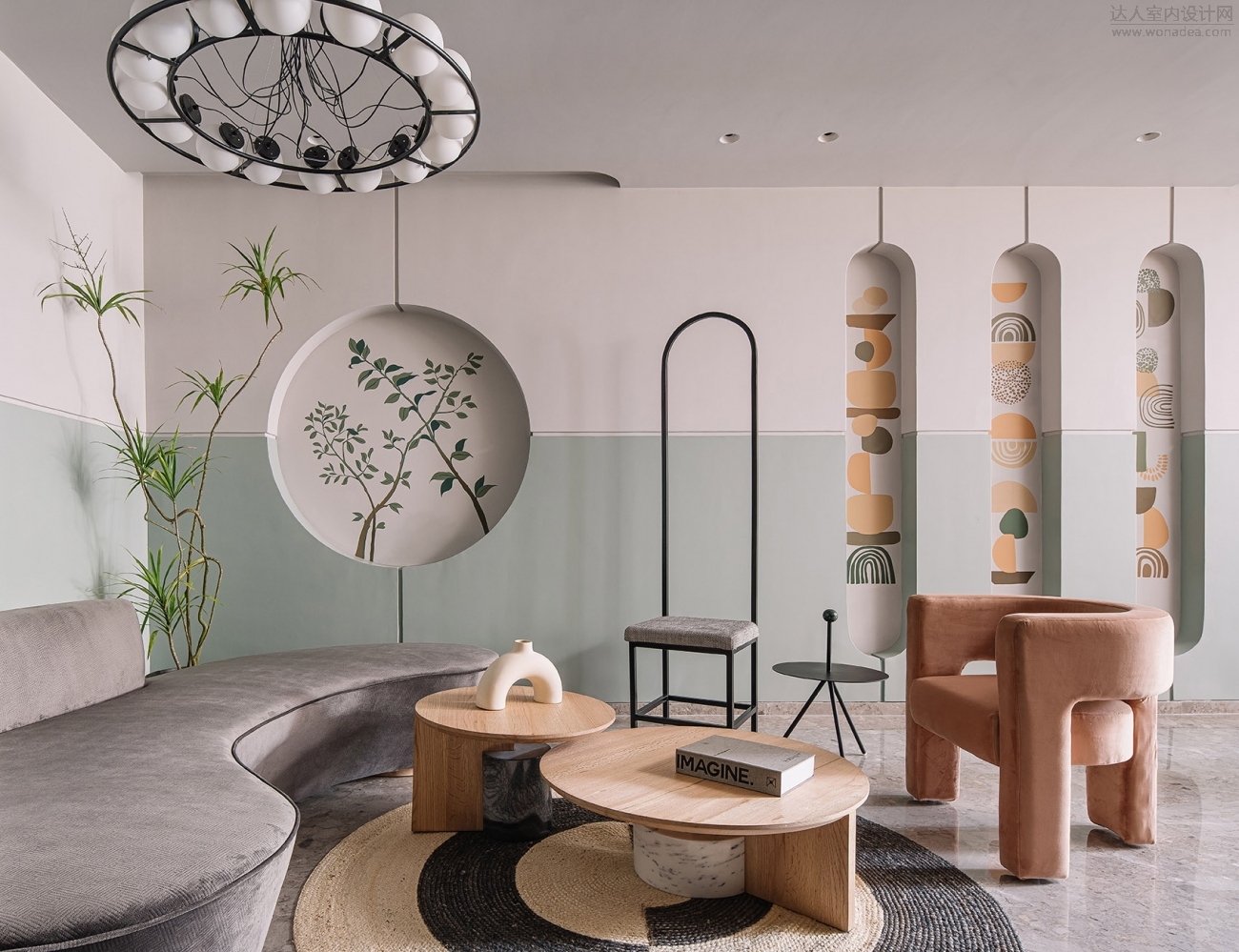
房屋的主人是一对喜爱旅行的年轻夫妇,他们喜欢追赶当下的新潮事物,因此设计师采用柔和的曲线以及包豪斯风格的形式与色彩进行空间叙述,反映了业主的生活方式和个性。
The clients are a young, well-travelled couple who like to keep up with the modern-day trends. Hence, the space was given a unique identity reflecting their lifestyle and persona through the narrative of soft curves and Bauhaus inspired forms and colours.
▼门厅,Foyer © Ishita Sitwala

▼设计采用柔和的曲线和包豪斯风格元素 © Ishita Sitwala
A narrative of soft curves and Bauhaus inspired forms and colours

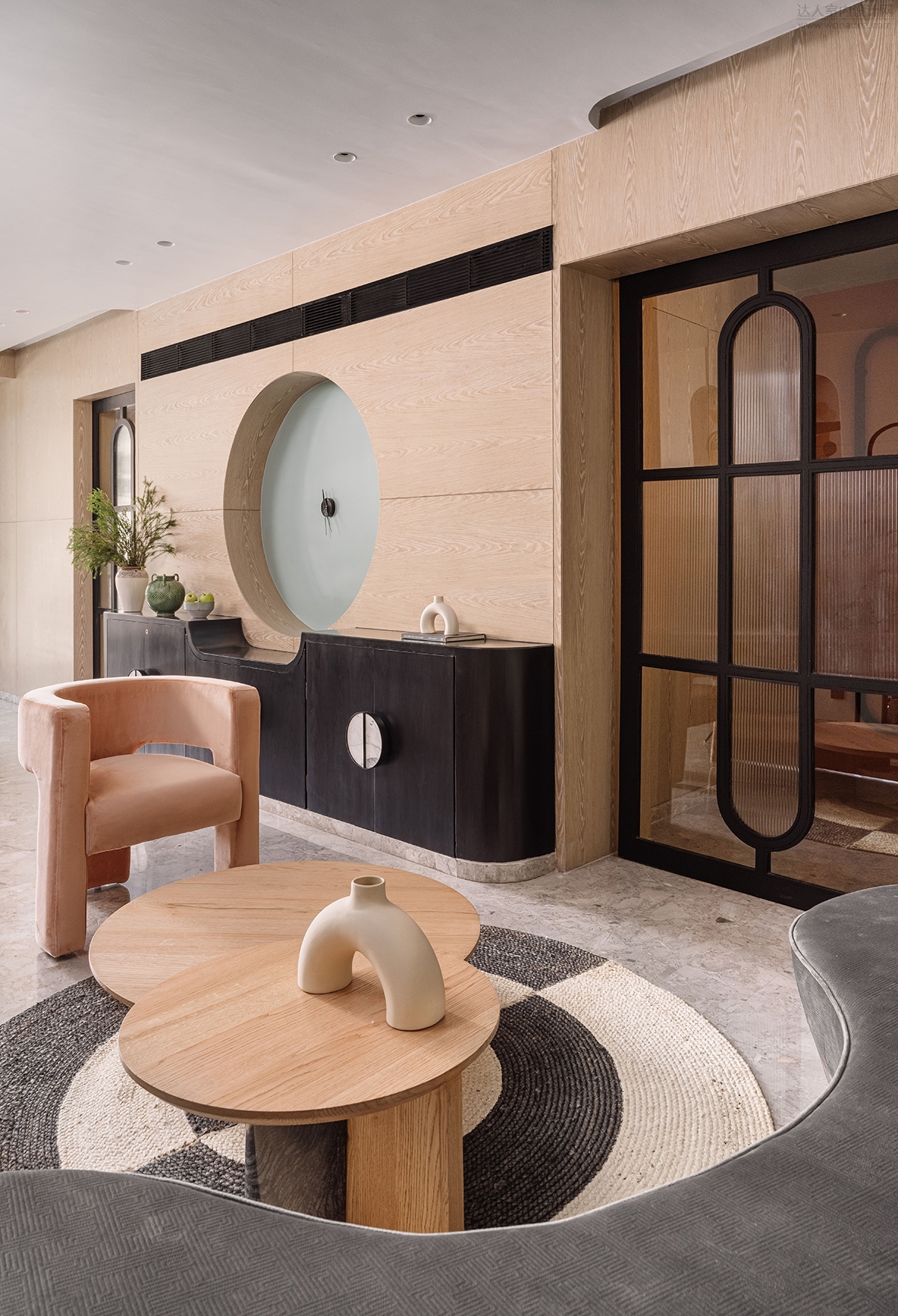
▼从餐厅望向客厅,View towards the living room from the dining room © Ishita Sitwala
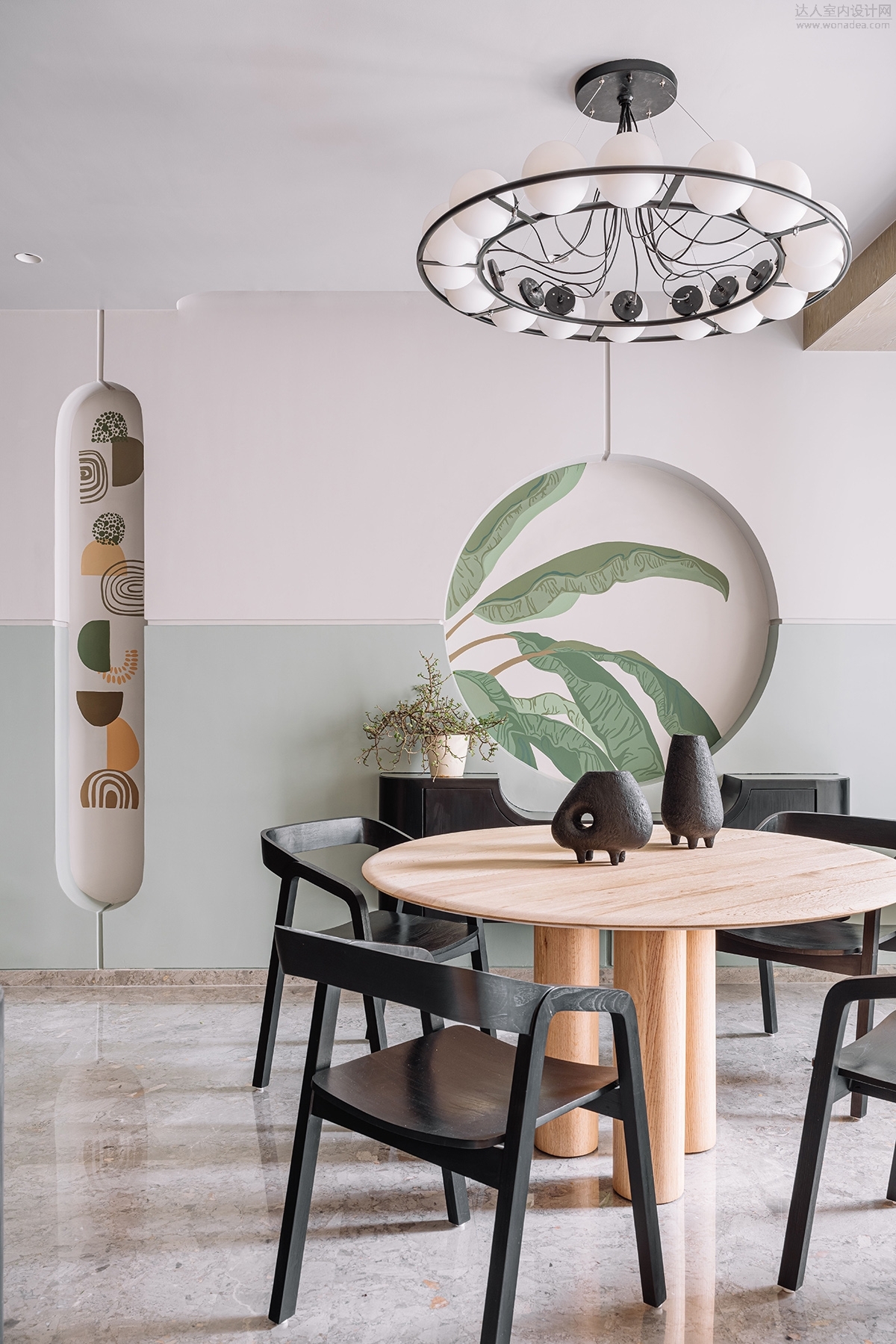
圆形和曲线型的壁龛是贯穿整个住宅的主题,包括浴室和公共区域的墙壁。业主的要求是根据功能来划分不同楼层,因此所有的公共区域,如客厅、餐厅和厨房都集中设置在首层,保姆房也位于该层,方便保护业主隐私。
The circular and curvilinear niches are a widely used motif throughout the house– be it in bathrooms or walls of common areas. The client brief was to divide the different levels according to the functions. Hence, the zoning was done in a way that all the public zones or common areas like the living room, dining area and kitchen were on the first level. The servant quarters were also provided on the first level so as to maintain privacy.
▼餐厅,Dining room © Ishita Sitwala
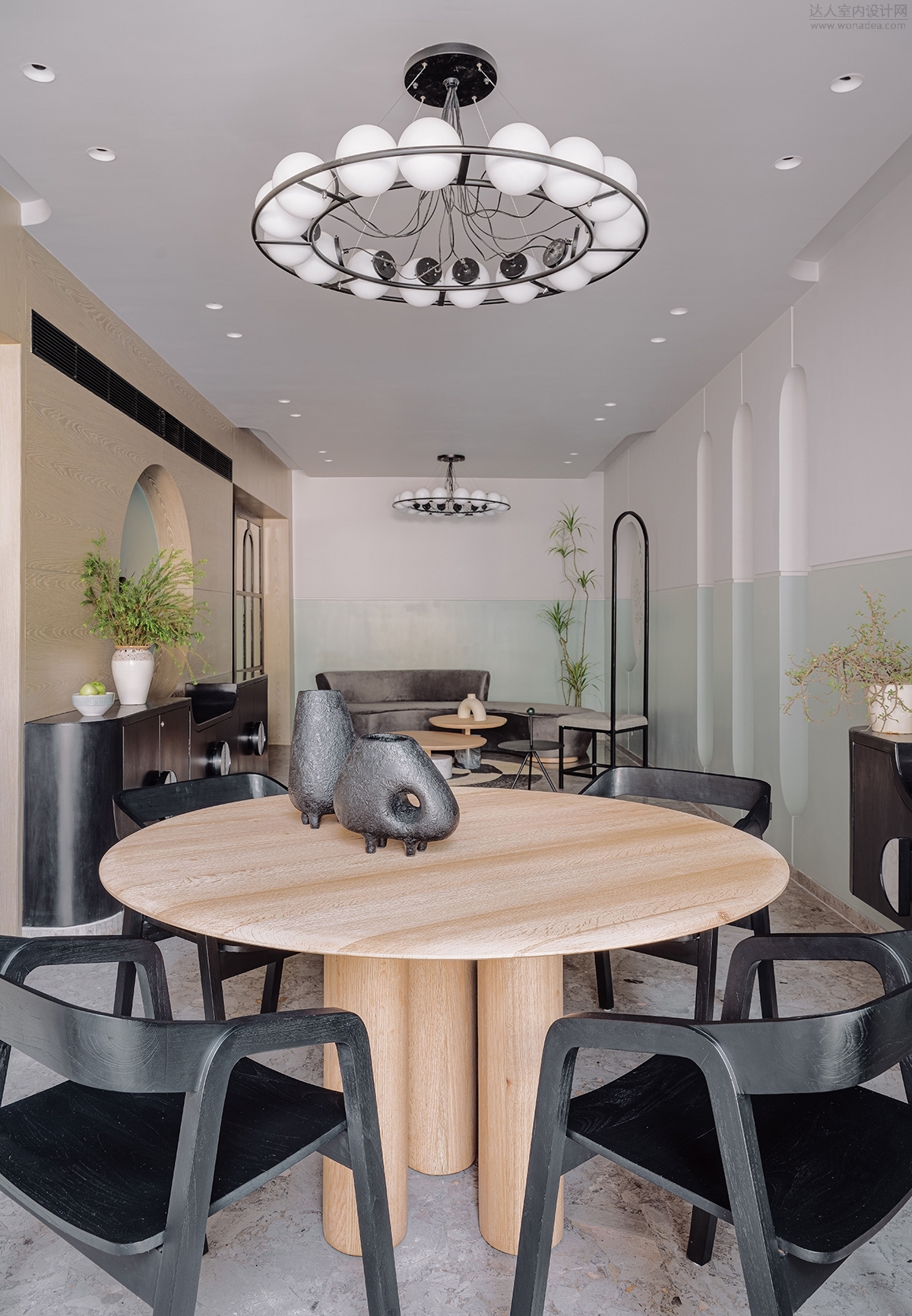
▼圆形和曲线型的壁龛是贯穿整个住宅的主题 © Ishita Sitwala
The circular and curvilinear niches are a widely used motif throughout the house
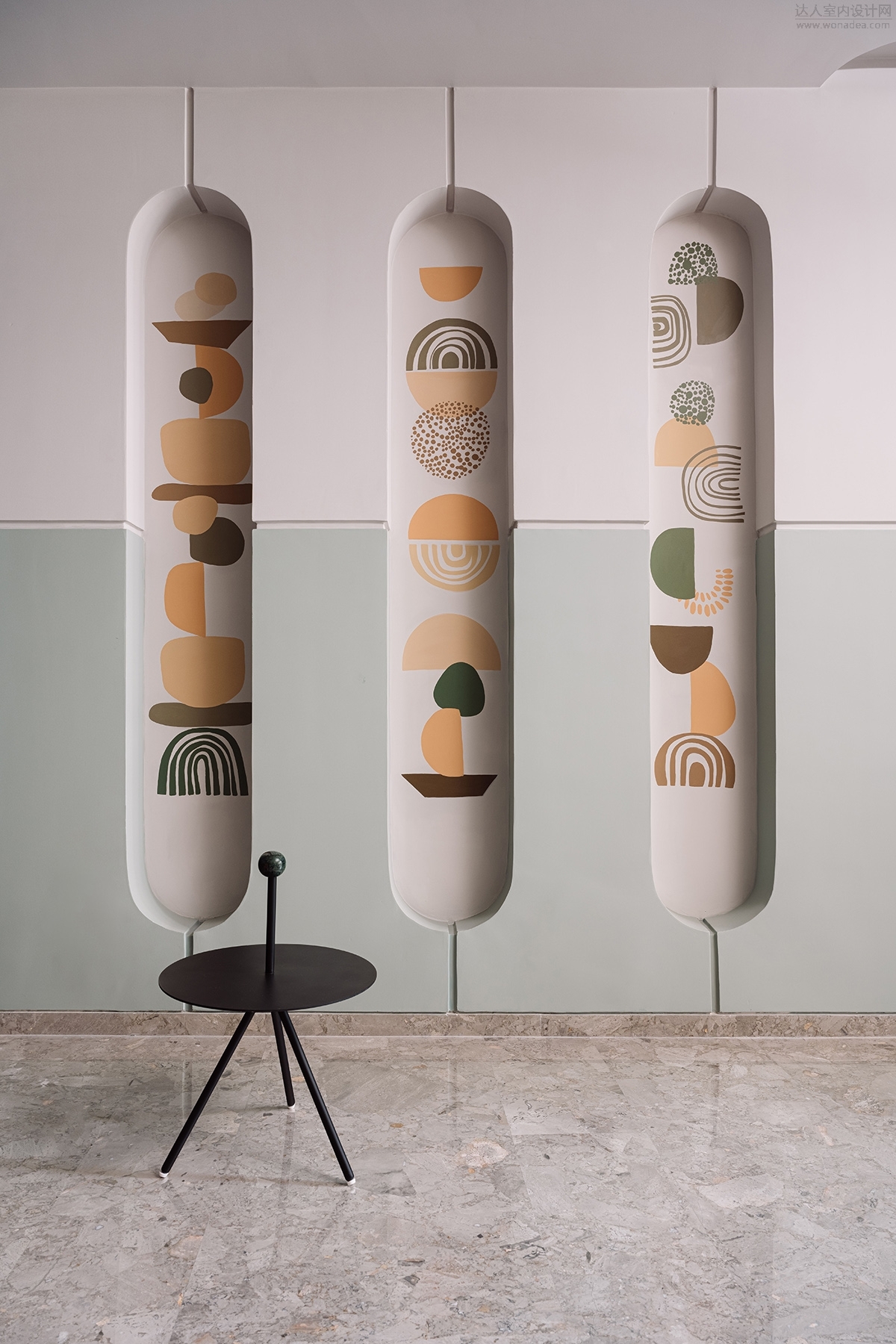

楼梯的处理方式使其呈现出柔和、无缝和圆润的效果,雕塑般的形态作为共同线索将空间的不同部分联系在一起,这也是项目名称“Upstairs”的来源。
Staircases, being the highlight here, are treated in a way so as to render a soft, seamless and curvy finish. They act as a sculptural element and a common thread that ties different parts of the space together– hence, staying true to the given name, Upstairs.
▼曲线型楼梯与墙壁无缝衔接,Curved staircase with seamless integration into the wall © Ishita Sitwala

▼楼梯间细节,Stair well detailed view © Ishita Sitwala
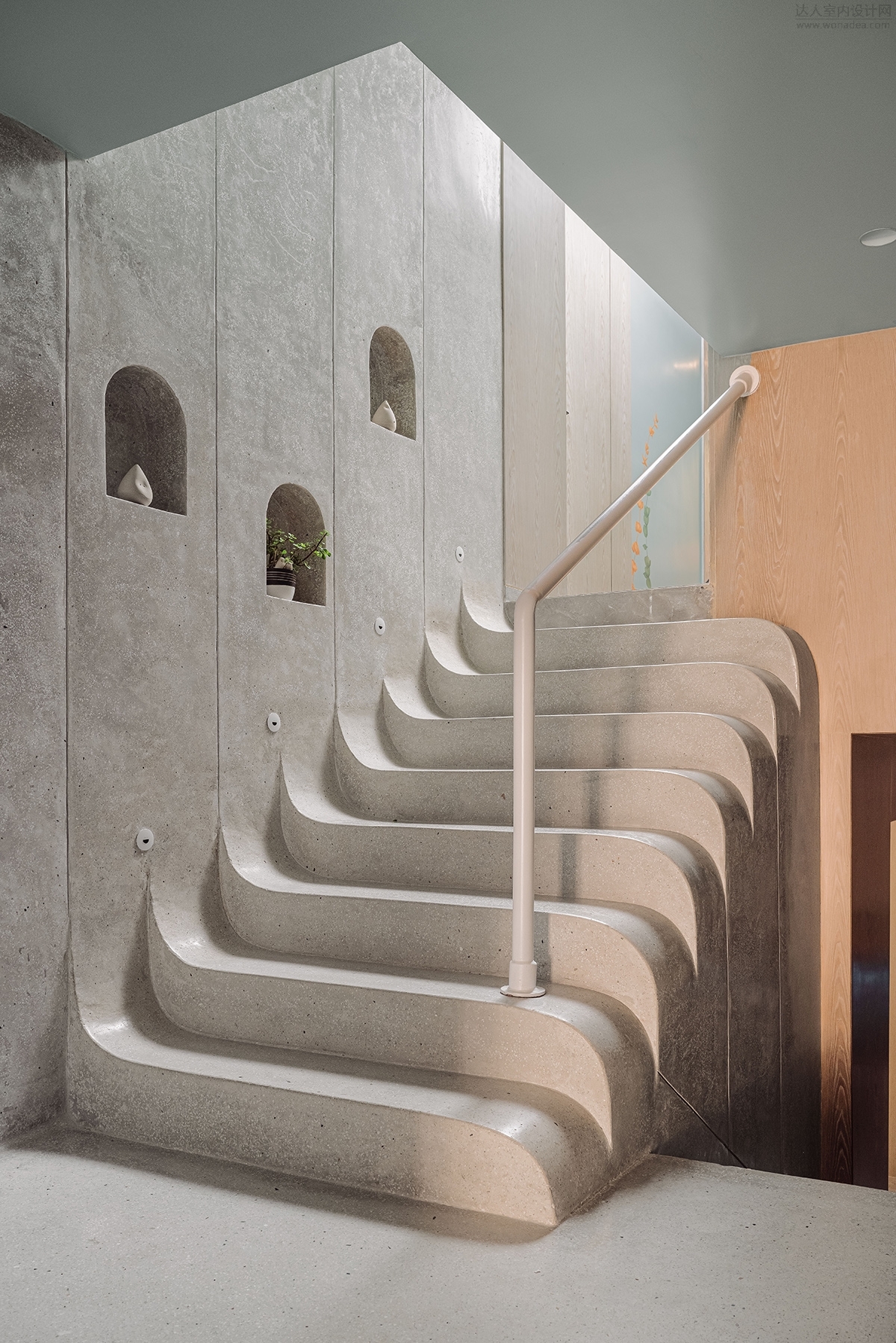
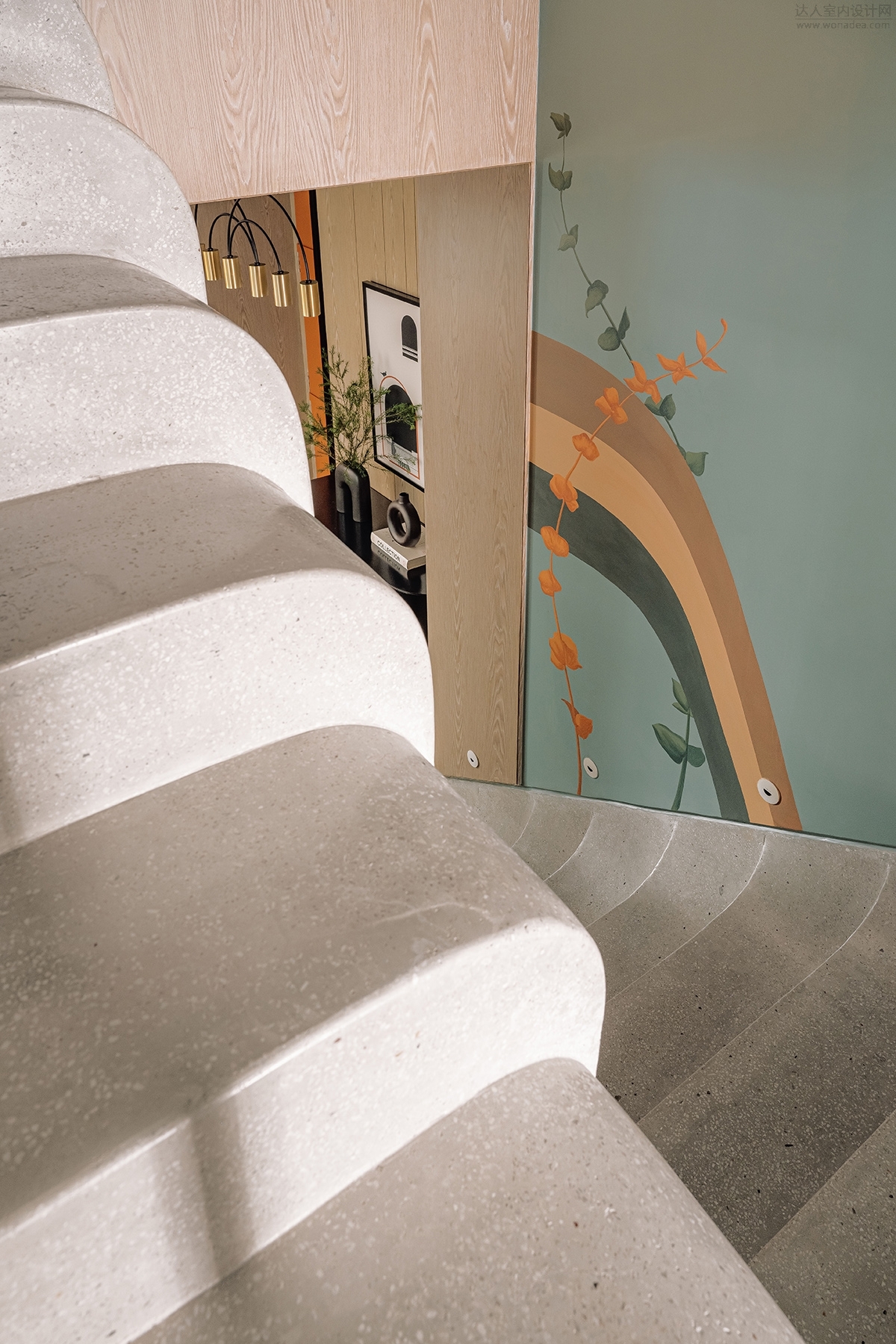
房屋二层包含所有的私人房间,如书房、带有步入式衣柜的主卧以及主浴室,此外还设有一个宁静的阳台。三层包括客卧、儿童房和杂物间。分层式的设计能够很好地满足划分功能区域的需要。
The second level includes all the private rooms like the private den, master bedroom complete with a walk-in closet, a master toilet and a serene balcony. The third level comprises of the guest bedroom, kid’s room and utility zone. In this case, the split level naturally allowed us to divide the spaces based on use.
▼二层休息室和书房,The den and the study © Ishita Sitwala
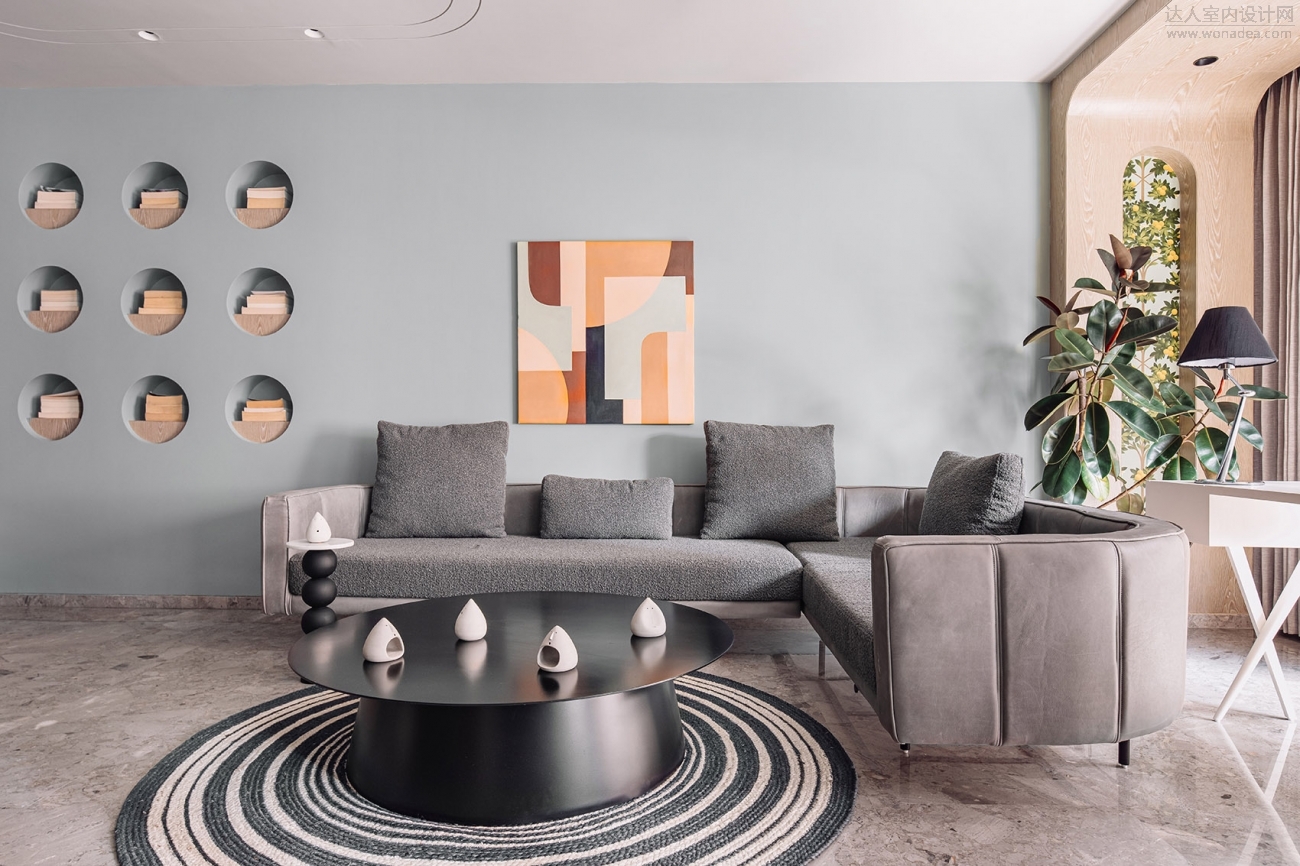
▼室内细节,Interior detailed view © Ishita Sitwala
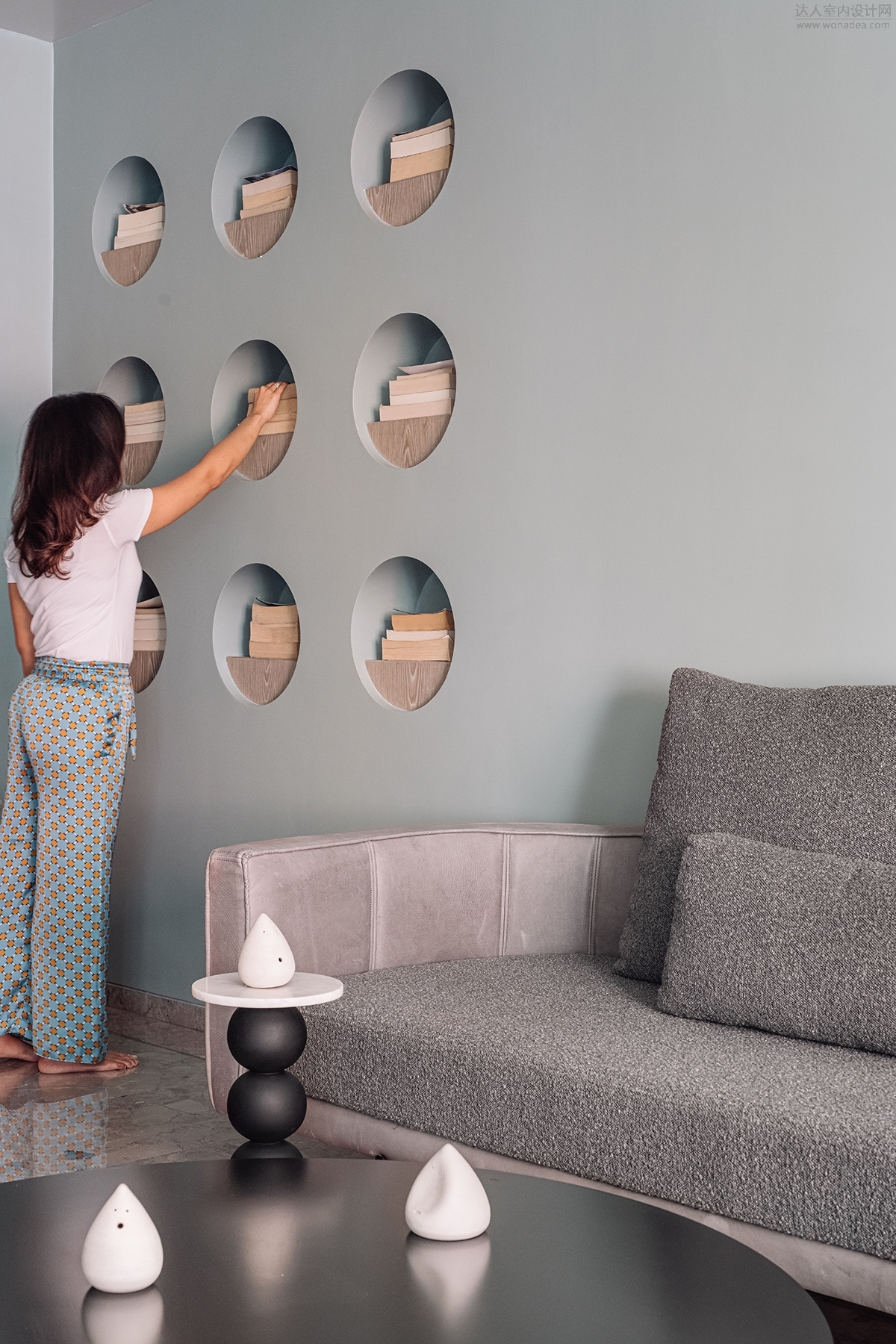
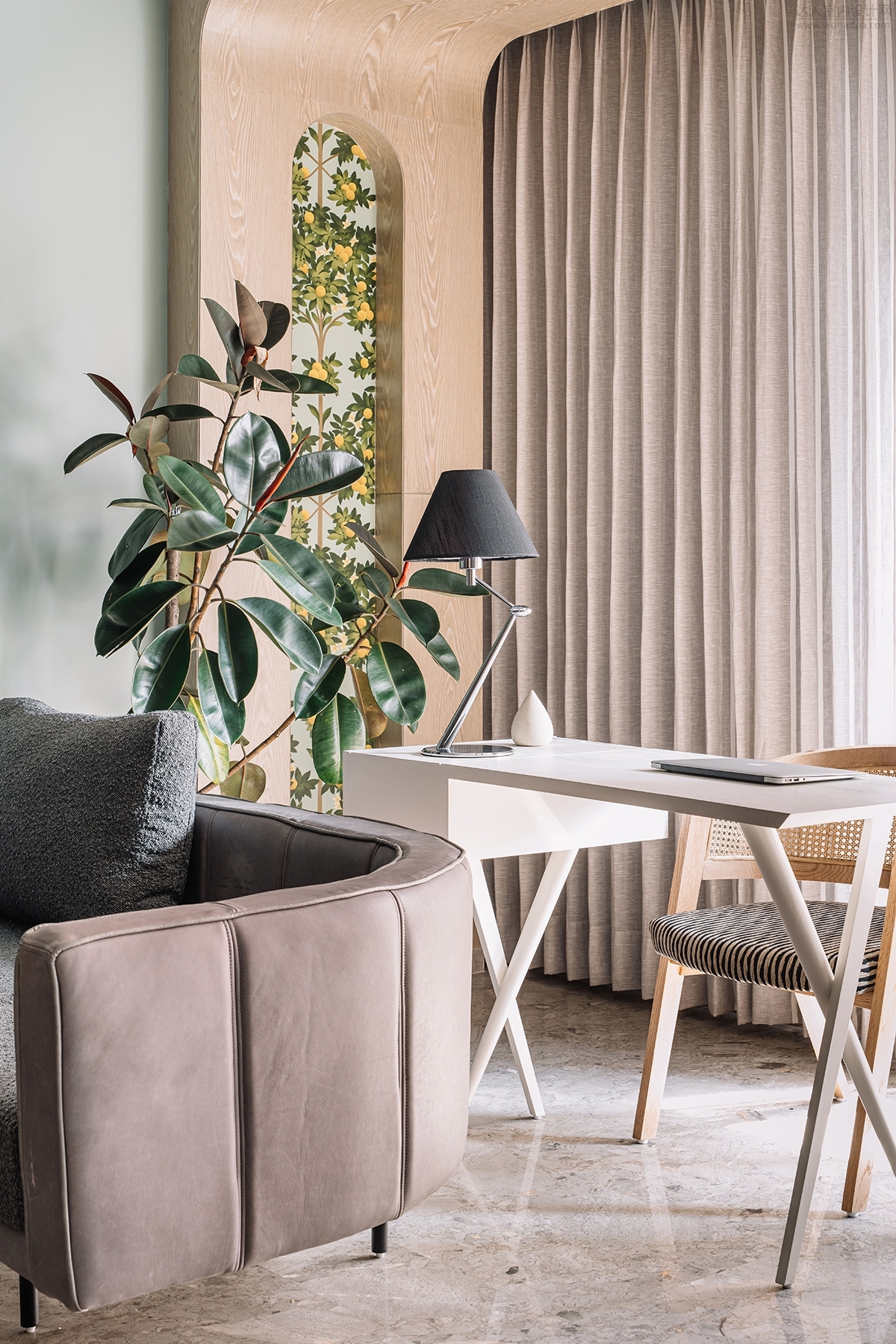
▼主卧室,Master bedroom © Ishita Sitwala
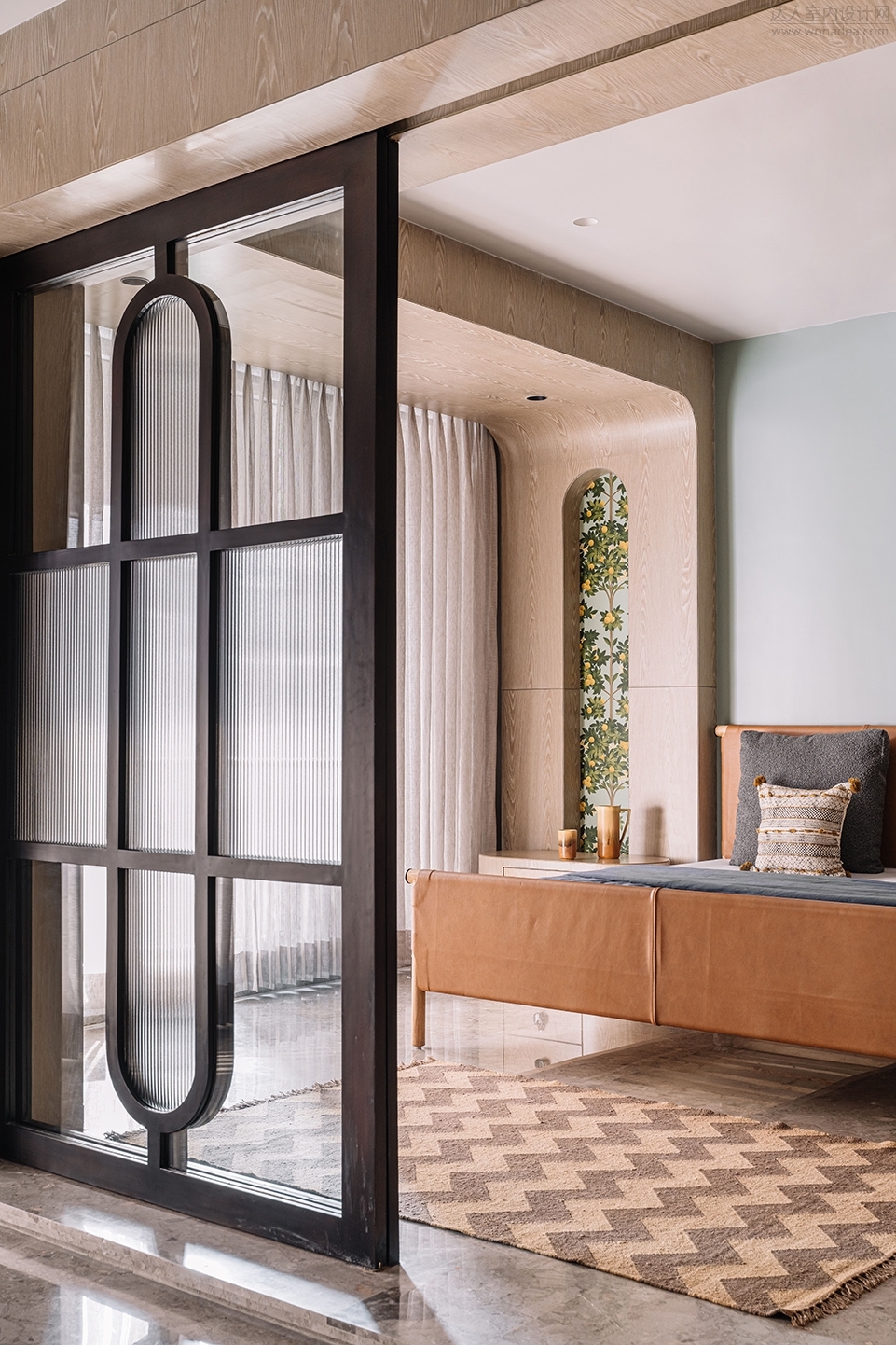

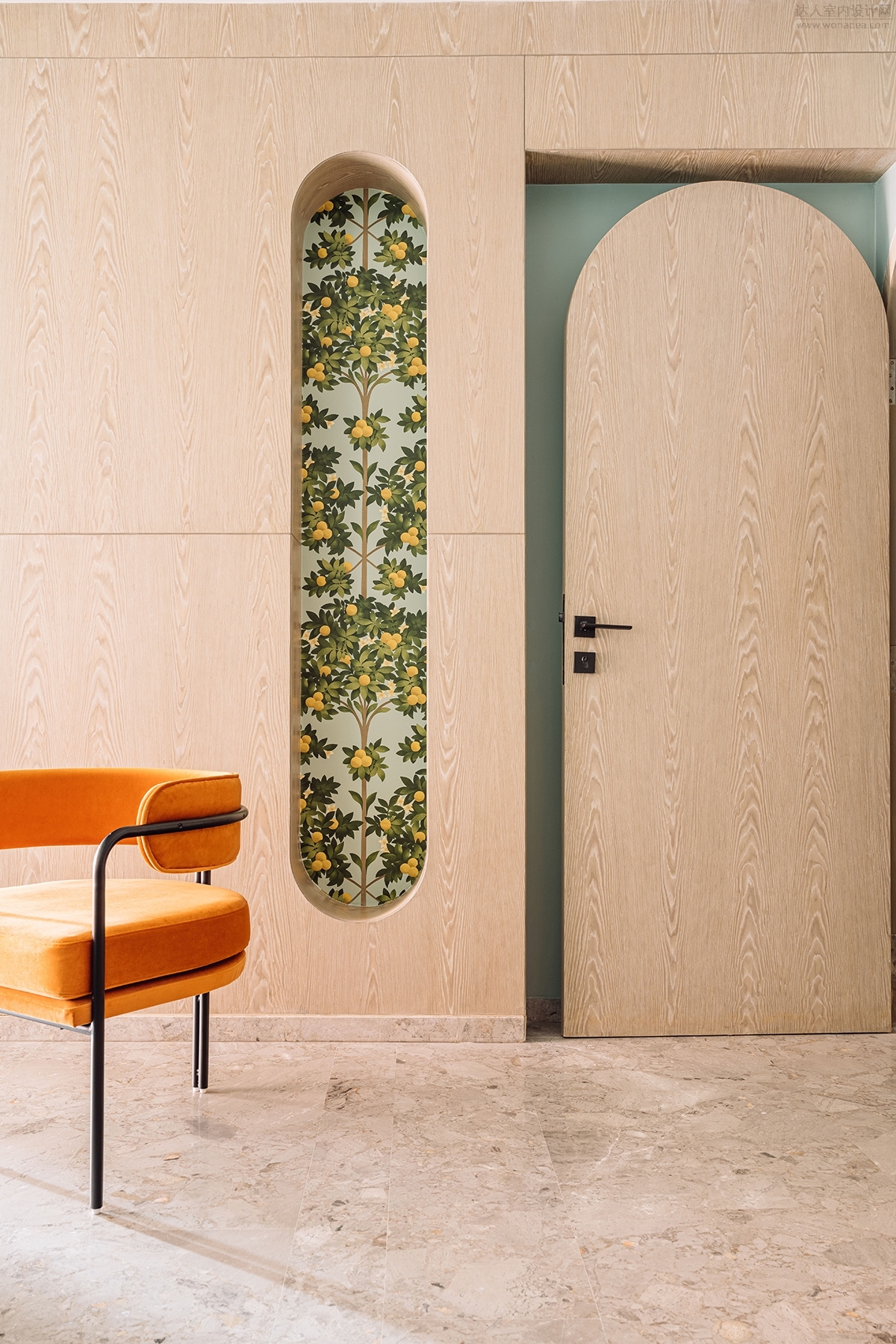
设计中最具挑战性的部分是对结构的处理,因为既有建筑已较为老旧。原有的墙壁都是歪歪扭扭的样子,所有的横梁和立柱都暴露在外面且未保持平齐。对此,设计师采用双层墙来纠正空间序列,并试图将旧墙拉直。圆形和椭圆形的壁龛起到了强调墙面的作用,使空间看上去更具活力和趣味,同时也更符合整个设计的叙事。双层墙可以帮助节约资源并提高耐久性,降低了通常情况下建造壁龛所需耗费的成本。
The challenging aspect was dealing with the structural part as the building was quite old. The walls were all crooked without any alignment. All the beams and columns were exposed and not in line with one another. Hence, we decided to incorporate double walls to correct the alignment and straighten the walls. This allowed us to accentuate the walls with numerous round and oval niches making the space feel more dynamic, interesting and in line with the narrative of the design. Double walling helped in saving resources and adding durability as otherwise, the process of creating niches would have increased the costs.
▼走廊,Passage © Ishita Sitwala
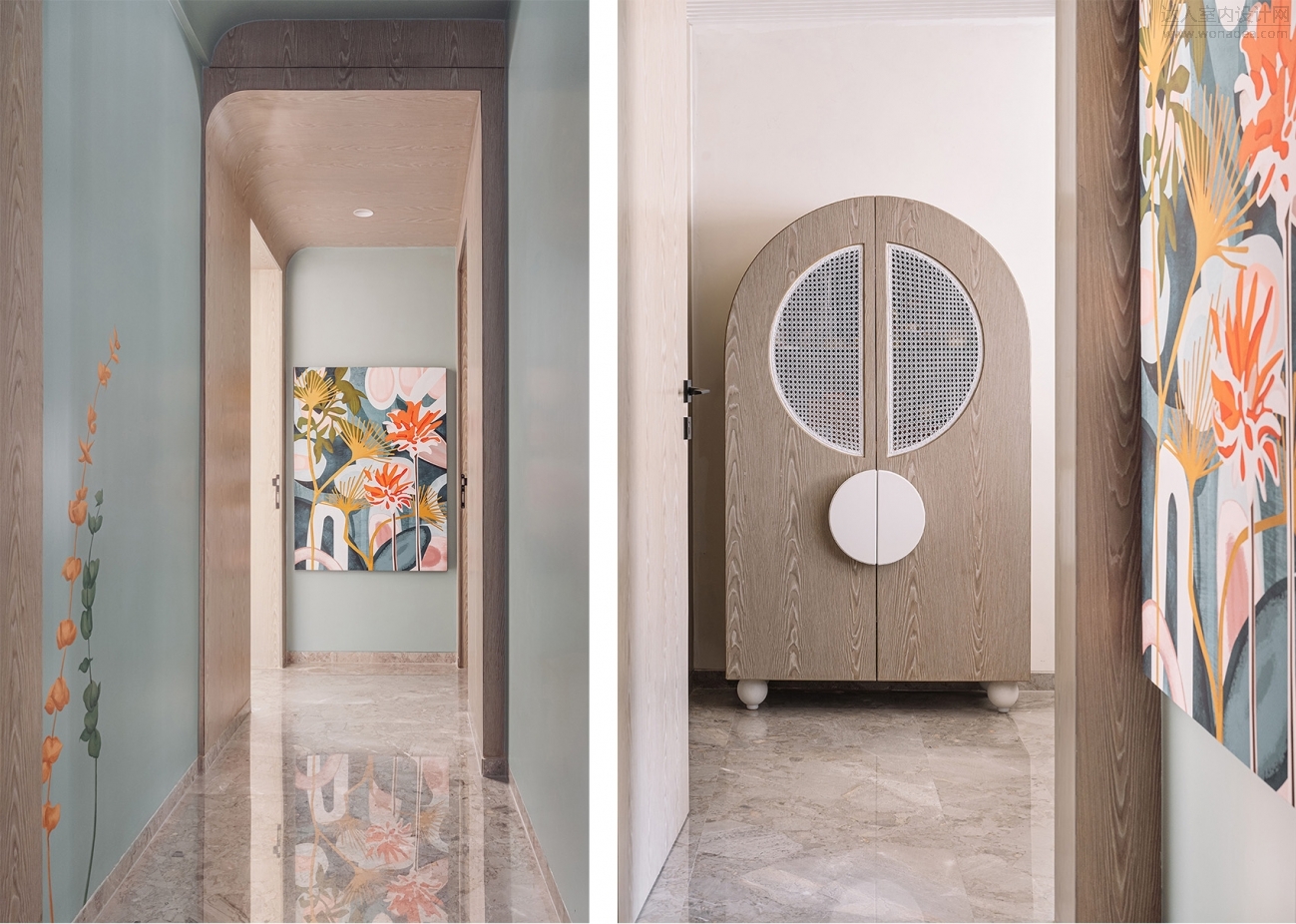
▼客人卧室,Guest room © Ishita Sitwala
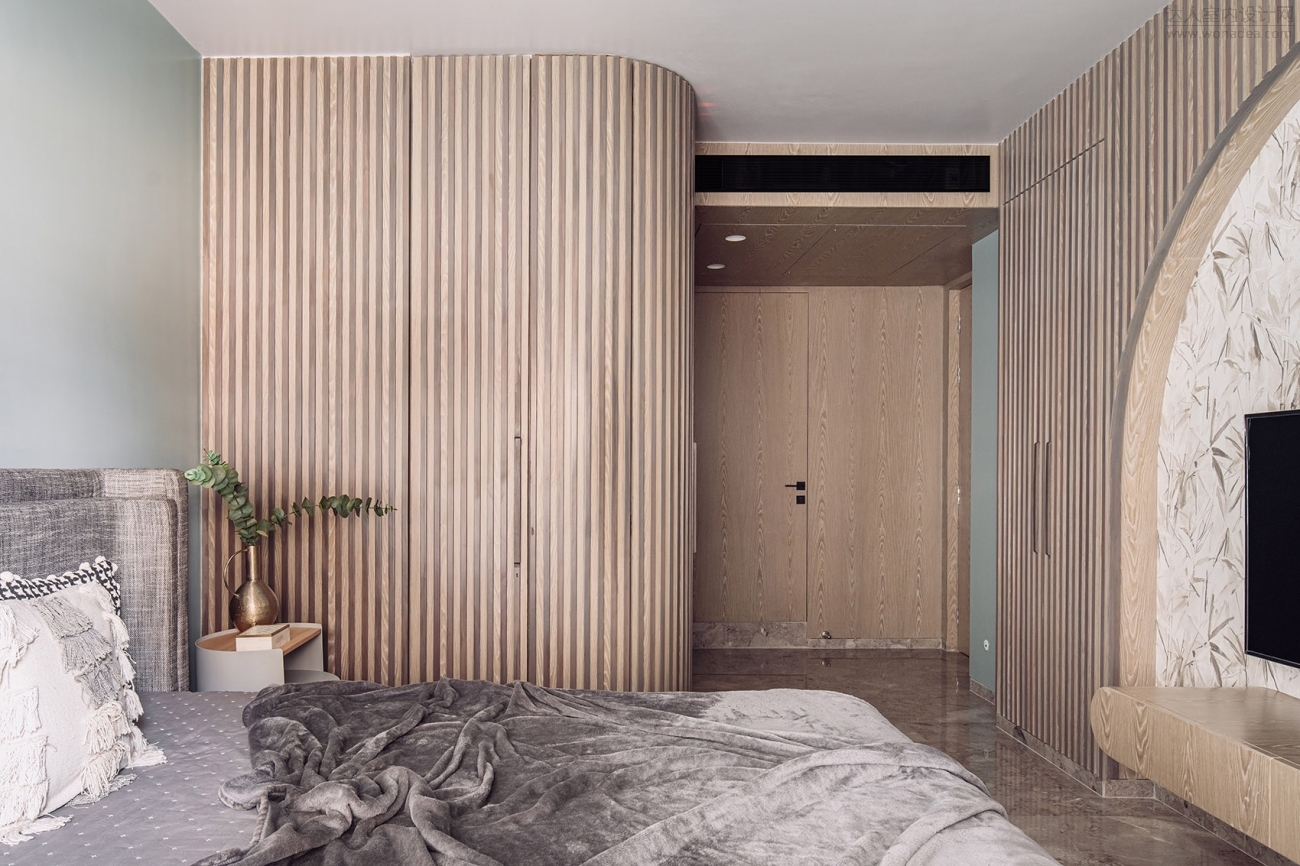
在材料方面,大部分空间并未使用传统的木板,取而代之的是单一的胶合板饰面,后者被应用在全部三个楼层中。空间的个性化元素避免了单调的感觉,有助于增加房间的特色。翡翠绿带来青春气息和现代感,大量的曲线型家具、炭黑色的饰面与定制把手和手绘壁龛墙相得益彰,让整个空间看上去更加完整和统一。
In terms of materiality, wood panelling was avoided in general. Instead, a singular veneer is used throughout the three levels. However, the personalisation of spaces is done to some degree to avoid monotony and add to the character of the rooms. Jade green was used to bring youthful energy to the space and make it feel more contemporary. A lot of curved furniture and black charcoal finish were used with customised door handles and hand-painted niches, making the entire space seem cohesive and guided by a singular design narrative.
▼胶合板墙面搭配炭黑色曲线型家具 © Ishita Sitwala
Veneer surface is complemented with curved charcoal furniture
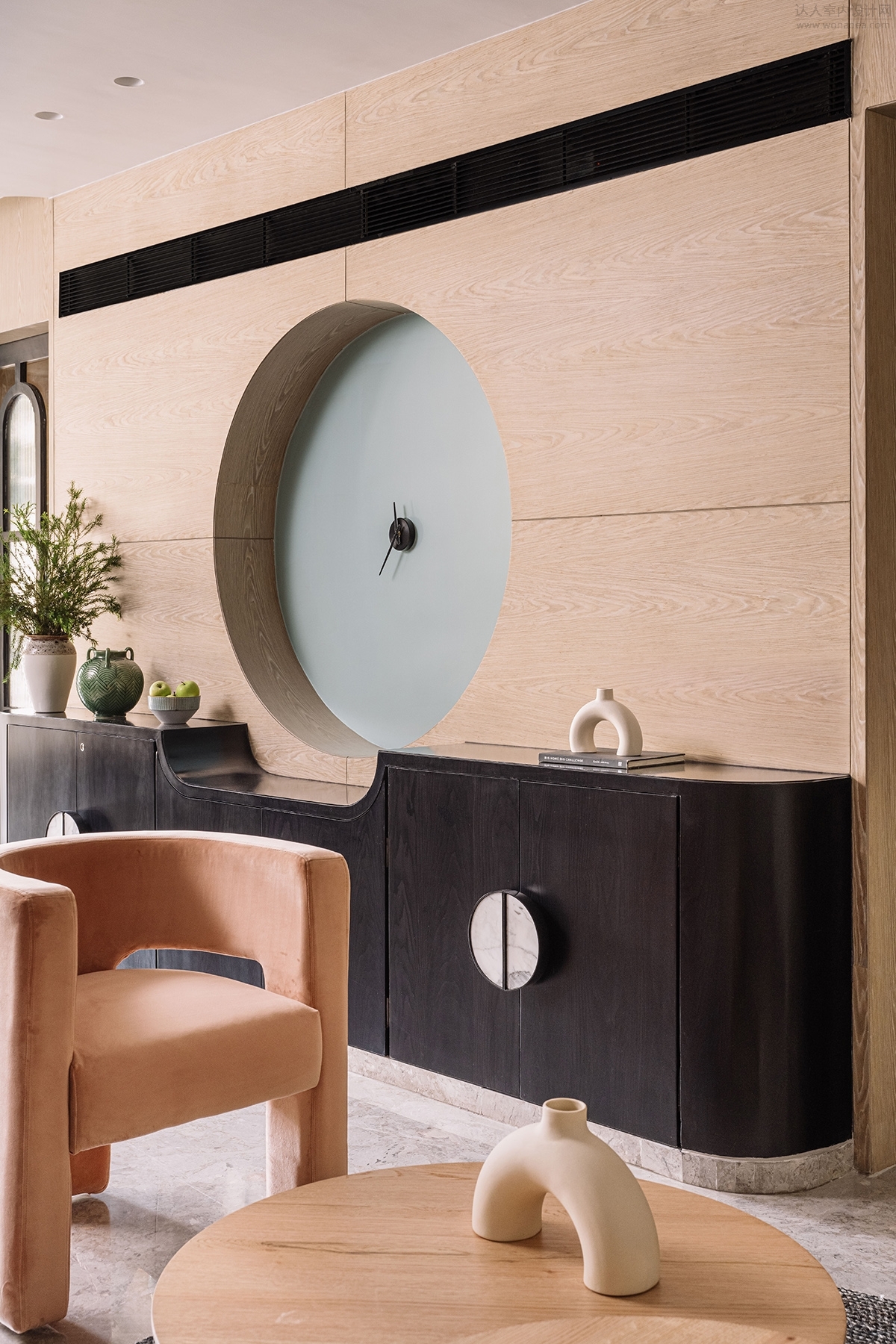
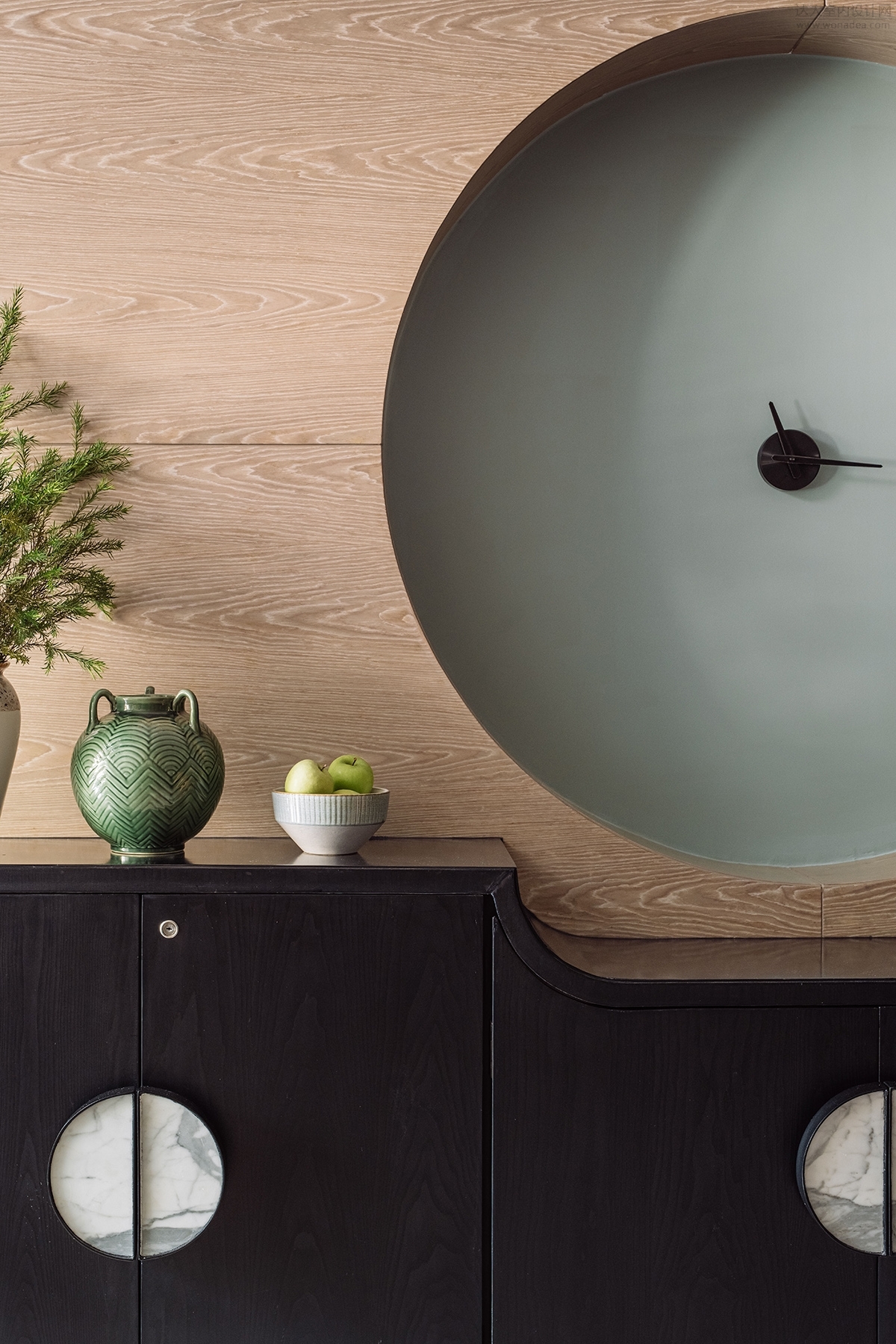
▼壁龛细节,Details © Ishita Sitwala
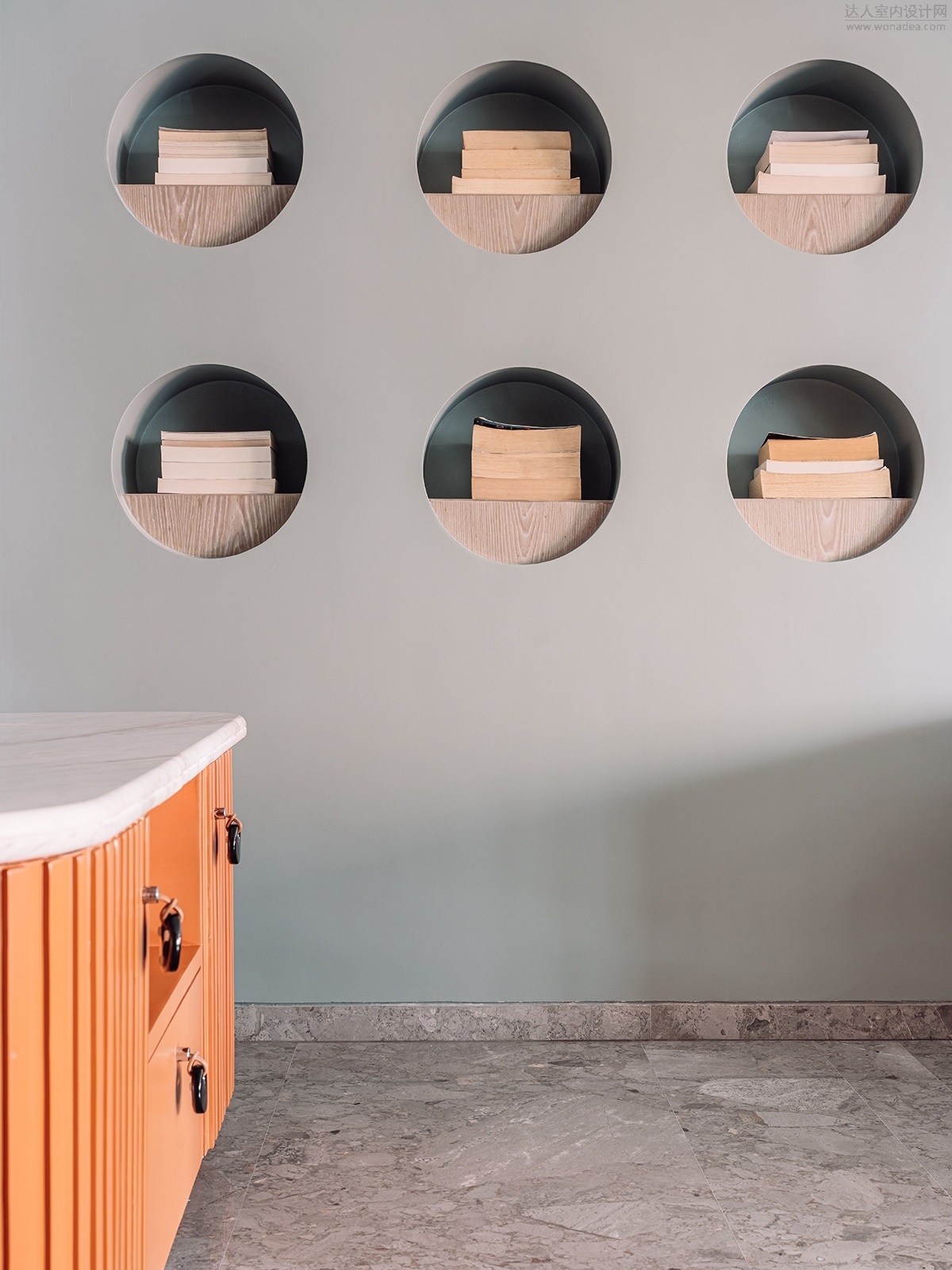
▼一层平面图,Plan 1F © Spaces & Design
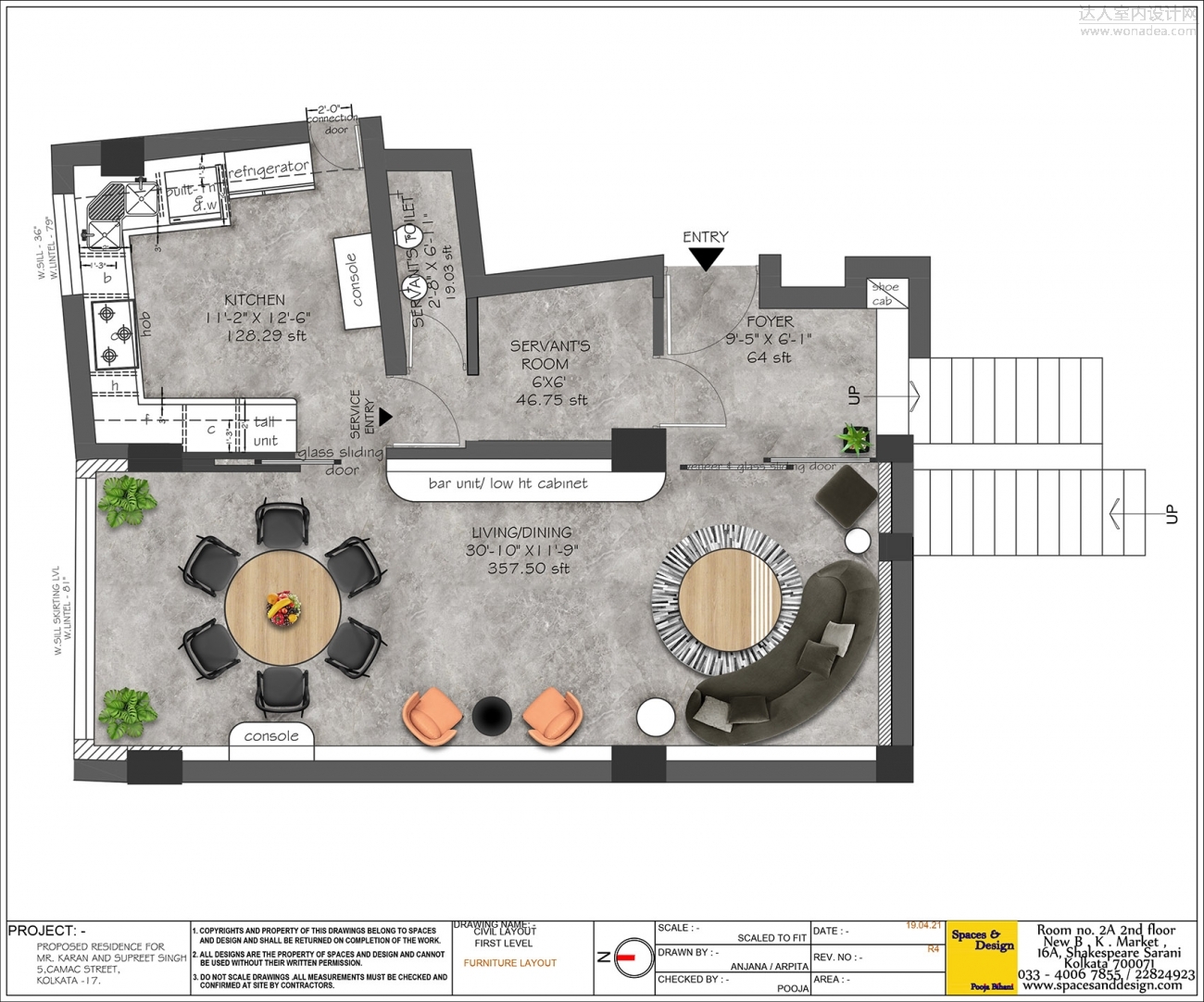
▼二层平面图,Plan 2F © Spaces & Design
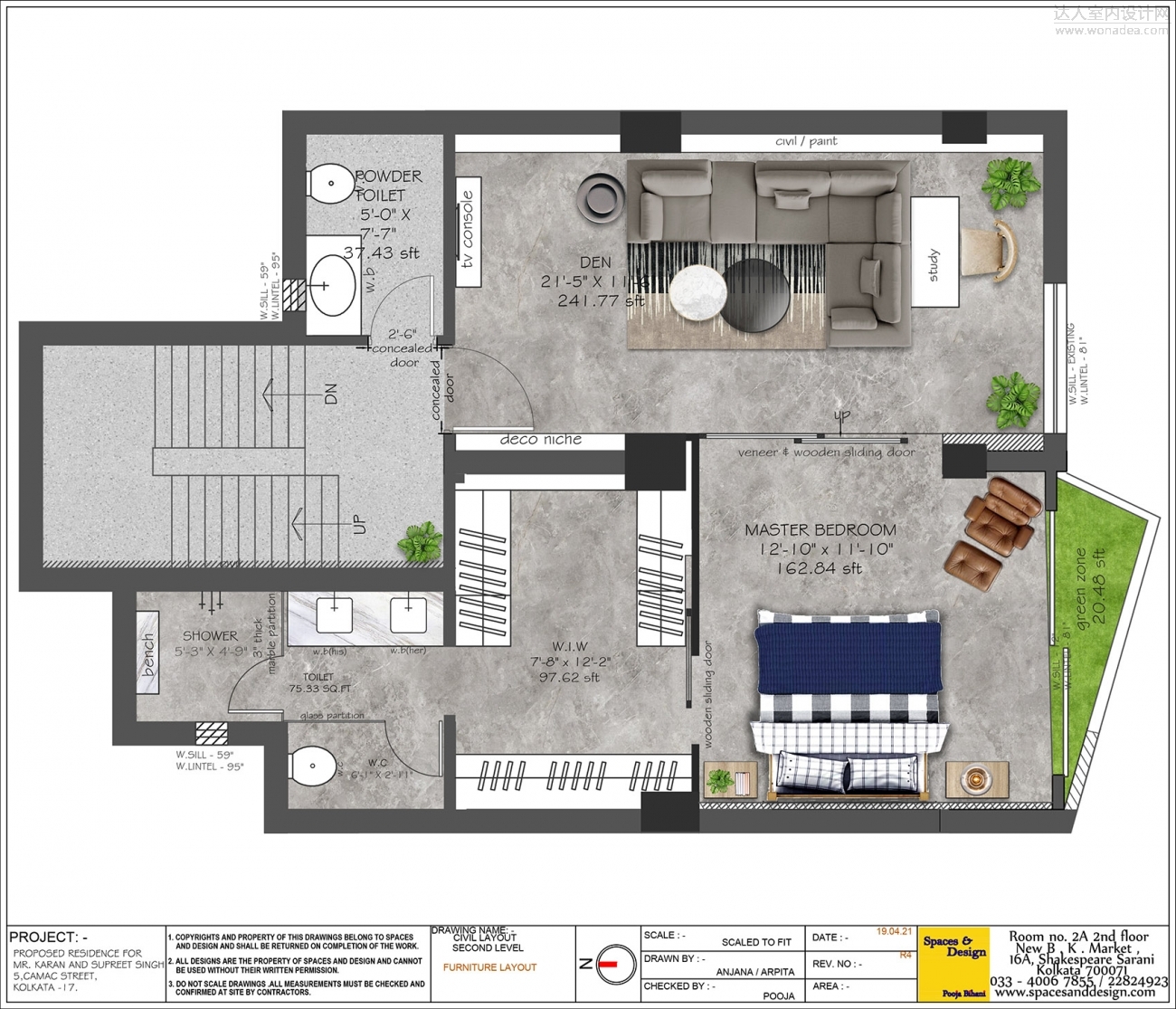
▼三层平面图,Plan 3F © Spaces & Design
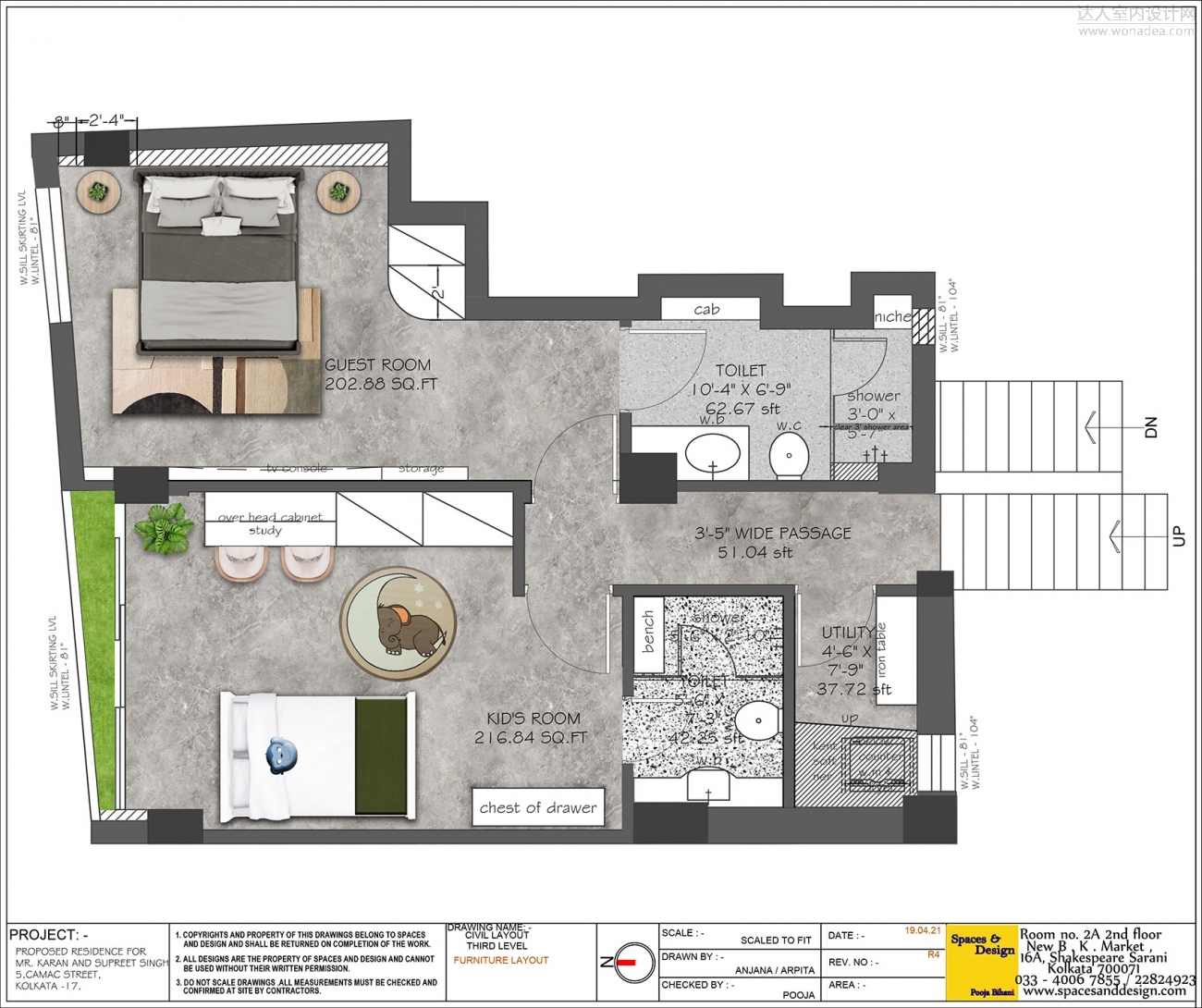
|
|
![启蔻芦花品牌活动进群礼[成都市]](data/attachment/block/49/4930ab6c3203cc125d83371f32e299c9.jpg) 启蔻芦花品牌活动进群礼[成都市]
启蔻芦花品牌活动进群礼[成都市]
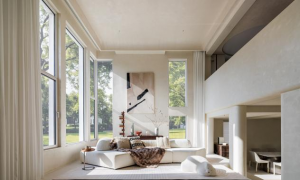 与时光共居|奶油侘寂风的自然疗愈力
项目名称|Project Name:《与时光共居|奶油侘寂风的自然疗愈力》
项目地址|Location
与时光共居|奶油侘寂风的自然疗愈力
项目名称|Project Name:《与时光共居|奶油侘寂风的自然疗愈力》
项目地址|Location
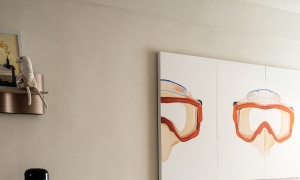 南昌阿鹤设计 |夏天的风还是吹到了理想家
这是一个精装房改造。
业主带着过往的生活经验重新看待它,有三点是需要重点强调的—
南昌阿鹤设计 |夏天的风还是吹到了理想家
这是一个精装房改造。
业主带着过往的生活经验重新看待它,有三点是需要重点强调的—
 办公空间|旌旗展
办公空间|旌旗展
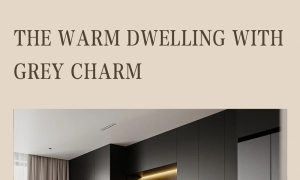 文山设计·王啸|灰韵暖居
文山设计·王啸|灰韵暖居
 与时光共居|奶油侘寂风的自然疗愈力
项目名称|Project Name:《与时光共居|奶油侘寂风的自然疗愈力》
项目地址|Location
与时光共居|奶油侘寂风的自然疗愈力
项目名称|Project Name:《与时光共居|奶油侘寂风的自然疗愈力》
项目地址|Location
 南昌阿鹤设计 |夏天的风还是吹到了理想家
这是一个精装房改造。
业主带着过往的生活经验重新看待它,有三点是需要重点强调的—
南昌阿鹤设计 |夏天的风还是吹到了理想家
这是一个精装房改造。
业主带着过往的生活经验重新看待它,有三点是需要重点强调的—
 办公空间|旌旗展
办公空间|旌旗展